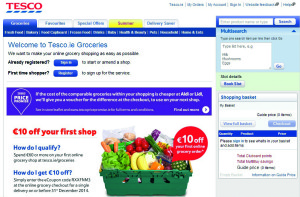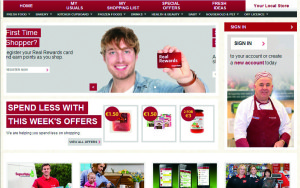In line to win online

With the government recently announcing almost one million homes and businesses in rural Ireland will be connected to high-speed broadband next year, is it wise for any retailer to ignore the potential offered by online sales? Gillian Hamill examines the potential pitfalls and rewards of trading online
13 August 2014
Has Marks & Spencer provided a cautionary tale in how not to launch a new website? Sales at the UK-headquartered chain have reportedly fallen 8% over the past three months, with most of the blame being attributed to its new online offering. Customers found glossy-magazine-style articles and videos about the latest style trends, to be something of a distraction when it came down to the hard and fast business of simply making their purchases. What’s more, this confusion will take some time to ‘bed down’, with M&S head honcho Marc Bolland only expecting a return to growth before the major Christmas trading months of November and December.
‘User unfriendly and awkward’
The retailer has reported that of the six million customers who used its old website, which was operated by Amazon, roughly half of these shoppers have registered for the new site. While the M&S Facebook page attracted plenty of comments about the new site being “user unfriendly and awkward”, Alan Stewart, the group’s finance director was adamant that nothing “had gone wrong” regarding the website’s launch. Incidentally, yes, this is the same Alan Stewart who has just been poached by Tesco to take up the same position there; so it’s safe to assume he must be doing something right!
According to Stewart: “We already flagged this earlier in the year [in May] that the settling-in period for the new site will impact sales…It is a bit like going to the supermarket for milk, they’ve moved it and you can’t find it immediately.”
Shore Capital analyst Clive Black was somewhat harsher, describing the situation as a “dotcom fiasco” which overshadowed an improving picture in womenswear and in-store; leaving a “bitter taste for investors”. Black damningly added: “M&S doesn’t seem to be able to spin all the plates at the same time.”
People don’t like ‘change’
Online tech website Webnetism.com has raised some interesting points about why the new website – which was launched to a glorious fanfare – proved to be more of a damp squib. As it sagely points out: “It’s official – People don’t like “change”! Every time Facebook makes even the smallest change there’s rioting in the streets, angry emoticons and glum looking selfies everywhere. But after a couple of weeks you really wonder what all the fuss was about.” That said, Webnetism goes on to give some valuable advice about how to avoid “some big mistakes” made by the retailing stalwart. These include the recommendation that sometimes a wiser approach can involve taking “baby steps”, rather than attempting to make several significant changes all at once. It concedes, that: “Yes, a “big bang” launch can have that “wow-factor” and gives your marketing team something to drool about, but sometimes a more cautious and phased approach is desirable.” To this end, Webnetism cautions that when hoping to sell goods from a website, that it’s preferable to: “Introduce new designs and features gradually…Bring [customers] along on the journey with you and invite their feedback at every stage. If something’s not working you can change it (or drop it) earlier with far less cost and impact on sales.”
Avoid overwhelming with content
Another useful piece of advice is that providing style over substance is never likely to fare well. Lots of video content might seem like a good idea at the time but is it really going to enhance the customer’s shopping experience and actually make it easier for them to buy what’s on offer? After all, there is already an abundance of lifestyle blogs in existence where shoppers can view this type of content, but ultimately a retailer is not seeking to entertain their customers, but rather encourage them to buy! The ‘three-click rule’ is laid down as a sensible template to follow. Essentially, if it requires more than three clicks for a shopper to find what they’re looking for, then, sadly for the retailer, there’s a high possibility that you will end up losing that particular sale.
Another serious pitfall to avoid is ignoring the ‘back end’ of your website. M&S made the task of online shopping significantly harder for its existing customers, by forcing them to re-register their details in order to buy goods from the new site. This is a cardinal sin in online selling which Webnetism describes as “unforgivable”. Instead it advises: “If you’re going to amend your database as well as the website front-end, you really must make sure you have a data migration plan in place.”
 Comparing supermarket websites
Comparing supermarket websites
Taking all these points on board, how do our leading supermarket retailers square up when it comes to rating their online offering in Ireland? According to the latest market share figures from Kantar Worldpanel for the 12 weeks to 20 July 2014, Tesco is still holding on to its number one spot with a 25.6% market share of the overall market, with SuperValu hot on its heels at 24.7%. Although Dunnes Stores remains not too far behind in third position at 21.2%, for the purposes of this article it is effectively null and void, given that while it currently sells clothes online, there is no facility to buy groceries from DunnesStores.com.
The first factor of note when browsing both SuperValu.ie and Tesco.ie is that they both appear to be clearly laid out and easy to navigate. Both retailers are making a conscious effort to drum up more online trade. SuperValu.ie has an offer for first time shoppers that they can “Get €20 off when you spend €100 online”. Meanwhile Tesco.ie advertises an offer for “€10 off your first shop”. On both retailers’ sites, in-store categories and special offers are clearly shown in individual sections. Likewise both offer similar functionality in the form of the ‘My Usuals’ tab on the SuperValu site and ‘Favourites’ tab on the Tesco site. What this nifty feature means is that the lines that shoppers frequently buy are recorded in the site’s database. As most people often buy the same products during each shopping trip, usually just with a few minor tweaks, this facility makes their grocery shop significantly easier. The shopper can simply add to or amend this existing list of goods, rather than having to start from scratch each time.

Both SuperValu and Tesco have invested heavily in making their transactional sites as user friendly as possible
Enormous potential
This type of attention to detail is important because even though online sales currently account for a low percentage of overall grocery sales in this country, there is enormous potential for expansion, as more and more customers realise the convenience the service offers. According to Bord Bia’s ‘Tomorrow’s Shopper’ research the number of Irish consumers buying online continues to grow, with 94% of shoppers in Ireland purchasing online. Mobile and social commerce are showing significant growth, facilitated by portable, handheld devices and speedier networks. By 2015, nine out of ten consumers in Ireland will own a smartphone, with tablet ownership projected to reach 50%.
Irish spending on overseas sites
Ireland still has some way to go before catching up with our European neighbours in terms of driving online sales though. Bord Bia reports that in overall terms, European online sales are expected to double to €323 billion by 2018. Irish online sales are expected to account for €11.5 billion of that total figure. Currently 73% of all money spent online in Ireland goes to overseas sites and 50% of all Irish retailers are not trading online. This represents a substantial growth opportunity for Ireland’s digital economy, which is already growing at 10 times the rate of the rest of the economy*.
However while 50% of Irish retailers are yet to branch out from mortar and bricks to online clicks, Tesco has proudly proclaimed that it is “Ireland’s biggest online grocery provider”. A spokesperson for the retailer told ShelfLife: “Tesco has invested significantly to make online shopping easier and more convenient for customers. Grocery home shopping sales in Ireland have continued to grow with population coverage now at 86%. Tesco made over 500,000 home deliveries last year and nearly 100,000 customers have downloaded our new Price News App. The app has consistently been the number one or two top grocery app in the Apple Lifestyle download chart. ‘Click & Collect’ is now available in eight locations: Clarehall in Dublin; Carton Park in Maynooth; Naas; Bray; Greystones; Roselawn Blanchardstown; Wilton Square in Cork and Newbridge. Our new F&F online site for Irish customers is now live. Customers can order online at www.f-f.com with free returns.”
SuperValu invests millions online
Stats such as the above undoubtedly make for impressive reading. When we contacted SuperValu, the group was equally keen to point out the strides that it has made within the online sector. This is despite the fact that online shopping currently accounts for less than 5% of SuperValu’s overall sales – which at first glance, appears relatively low but perhaps is not so surprising when the broad diversity of Ireland’s shoppers is considered. “To date we have invested several millions in our omni-channel capabilities for the SuperValu brand,” a spokesperson said.
“Specifically looking at SuperValu’s online shopping service, the service is now available to approximately 85% of the country and we have integrated the Superquinn online shopping service into our existing service,” he added.
Essentially, if it requires more than three clicks for a shopper to find what they’re looking for, then, sadly for the retailer, there’s a high possibility that you will end up losing that particular sale
Ease of use was the foremost consideration behind the design of SuperValu.ie. “Shopping online with SuperValu is designed to be as simple as possible. Once you begin to shop online all the items you normally purchase are available on a readymade list in the ‘My Usuals’ section. All fresh products from our butcher, fishmonger and deli counters can also be requested according to preference i.e. certain cut of lamb etc. All of the special offers available in store are available in a central hub online and the service will even prompt customers if they are missing out on a multi-buy offer.”
What’s more, SuperValu offers a ‘click and collect’ service in all online stores. The group is also keen to point out its numerous technological ‘firsts’. According to its spokesperson: “We were the first grocery retailer in Ireland to offer a transactional shopping app. Available for iPhone or Android, in excess of 20% of our online orders are coming through our mobile app.” Moreover, in February 2014, SuperValu launched its first ‘Drive Through’ shopping service at its Carrigaline store in Co. Cork, and is currently looking at rolling out this service to other stores.He concludes: “Our ambition is to deliver the best brand experience across all consumer touchpoints; in-store, online, through direct marketing via hardmail, email and text that is in tune and personalised to our shoppers.”
It’s clear that SuperValu is determined to capitalise on the potential behind Ireland’s online market. A wise move in terms of differentiating itself from rivals. Especially when it’s considered that news within Ireland’s grocery sector has been dominated in recent years by the rapid rise of the discounters. Aldi and Lidl have both successfully attracted Irish shoppers by focusing on a ‘low cost, high quality’ message. Yet the online space is one they are conspicuously absent from, from a sales point of view; potentially giving the ‘traditional supermarkets’ breathing space to flourish. A spokesman for Aldi Stores (Ireland) told ShelfLife: “Aldi has no plans to introduce online shopping in Ireland at the moment. However, as a company we are constantly looking at new options to grow our business.” In a similar vein, it would be surprising if Lidl was to suddenly announce a new transactional website, given that the company which has become much more media friendly in recent years, has not shown any signs that this will be the case.
The only fly within the ointment in terms of online expansion, could be Ireland’s unimpressive broadband speeds, particularly within rural areas. However almost one million homes and businesses in rural Ireland are to be connected to high-speed broadband next year, following the government’s approval of an up to €500 million investment in a fibre-powered network. Perhaps it’s time for the 50% of Irish retailers who are not currently trading online to get entangled in the web?
*(Sources: EEI Online Trading Report July 2013, National Digital Strategy 2013)



 Print
Print




Fans 0
Followers